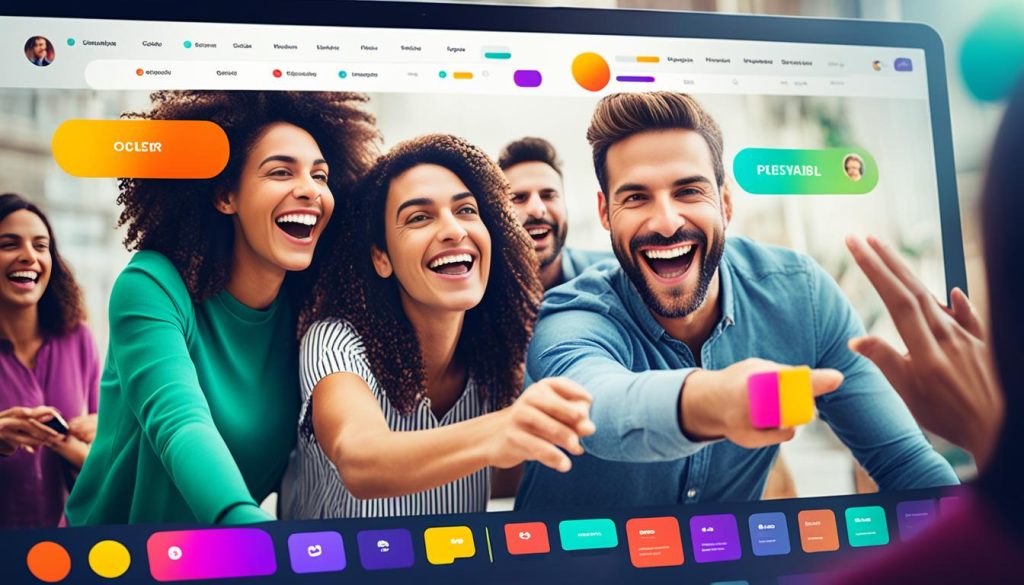Have you ever wondered why some content creators easily grab their audience’s attention? Others seem to struggle to get noticed. The answer is in creating engaging and valuable content that truly connects with your readers. Did you know over 90% of blog posts get zero traffic? But, with the right approach, you could be one of the few getting millions of views and high engagement.
It’s all about finding out what your audience needs and offering unique solutions. Use storytelling, visuals, and a friendly tone to make your content stand out. Are you ready to learn how to make content that truly captures and inspires your readers?
Let’s explore the strategies top creators use to make content that hits the mark and gets results. Get ready to boost your content creation skills and make a lasting impact on your readers.
Content Creation: The Art of Storytelling
In the world of content creation, storytelling is a key tool to grab your audience’s attention. By telling engaging stories, you connect with your readers on a deeper level. This creates a strong bond and leaves a memorable impact.
Crafting Compelling Narratives for Your Audience
Good storytelling is more than just sharing facts. It’s about creating a story that touches your audience personally. Use relatable characters, vivid details, and emotional stories to pull your readers in and keep them interested. Aim to make content that informs, inspires, and entertains.
Incorporating Visuals for Maximum Engagement
Adding visuals to your stories can take your content to the next level. Infographics, graphs, and charts make complex info easy to understand. Captivating images and videos make your stories come alive. By combining storytelling with visual content, you can engage your audience better and improve their experience.
| Storytelling Techniques | Visual Content Creation |
|---|---|
|
|
Mastering storytelling and using visuals can make your content more engaging and valuable. It helps you connect with your audience on a deeper level. By captivating your readers, evoking emotions, and leaving a lasting impression, you achieve success. The secret is in telling a compelling story.
Audience Analysis: Understanding Your Readers
As a content creator, understanding your target audience is key. By analyzing your audience, you can find insights that help shape your content. This way, you can connect better with your readers.
Start by using social listening tools to track what people talk about in your industry. This gives you info on what your audience struggles with, their challenges, and what they like. Also, use tools to see where your audience hangs out online, which platforms they use, and what content they like best.
Talking directly to your audience is another great way to learn about them. Consider doing surveys or having one-on-one chats to understand their needs and what content they value. This deep dive into your audience will help you make content that really speaks to them and keeps them interested.
Your audience is crucial to your content’s success. By taking the time to really get to know them, you can make content that not only teaches and informs but also moves and excites your target audience.
| Audience Analysis Techniques | Key Benefits |
|---|---|
| Social Listening | Uncover industry conversations, pain points, and preferences |
| Audience Intelligence Tools | Understand where your audience spends time online and their content preferences |
| Direct Audience Engagement | Gain insights through surveys, interviews, and one-on-one conversations |
Creating engaging blog content
To make your blog content engaging, go beyond just giving “best practice” tips. Focus on the unique challenges your audience faces. Offer practical solutions to make your blog a valuable resource.
Identifying Pain Points and Providing Solutions
First, really get to know what your audience needs and the problems they have. Do deep research, collect feedback, and look at your data to find out what keeps them up at night. Once you know their pain points, create content that offers real solutions and insights.
Going Beyond Best Practices for Unique Value
While standard best practices are a good start, aim to give more. Share your own stories, case studies, and strategies backed by data. This fresh perspective can grab your audience’s attention and make your blog a trusted source in your field.
| Traditional Best Practices | Going Beyond Best Practices |
|---|---|
| Generic, one-size-fits-all advice | Tailored solutions based on audience research |
| Surface-level problem identification | In-depth understanding of audience pain points |
| Regurgitated information | Unique, data-driven insights and experiences |
By focusing on your audience’s specific needs and offering more than just basic advice, you can make your blog content truly engaging and valuable. This approach will set your blog apart and make it a go-to resource in your industry.
Hooking Your Readers from the Start
In the world of content creation, catching your reader’s attention right away is key. Your intro sets the mood for the whole piece. A strong, irresistible introduction can make a big difference. It can keep readers hooked or make them leave. By learning how to hook readers, you’ll keep your audience interested and ready to explore more of your content.
Crafting Irresistible Introductions
Creating an irresistible intro is tough, but it’s an important skill. Here are some tips to help:
- Start with a question that makes your audience think and feel something.
- Begin with a story or anecdote that grabs the reader’s attention right away.
- Make a bold statement or share a surprising fact to spark curiosity.
- Use your words to paint a picture that takes the reader somewhere else.
- Add a quote that sets the tone for what’s to come.
Try out these ideas and see what works best by looking at your click-through rates and how long people watch your content. This way, you can improve your skills and always start your content with irresistible introductions that hook readers from the start.

| Technique | Potential Impact |
|---|---|
| Thought-provoking Question | Engages the reader’s curiosity and connects with their pain points or desires. |
| Captivating Anecdote | Immediately draws the reader in with a relatable and emotionally-charged story. |
| Bold Claim or Statistic | Piques the reader’s interest and compels them to continue reading to learn more. |
| Vivid Imagery | Transports the reader to a specific time and place, immersing them in the content. |
| Powerful Quote | Sets the tone and establishes the importance of the topic, while engaging the reader’s emotions. |
Conversational Writing for Better Engagement
To make a stronger bond with your readers, it’s key to use a conversational writing style in your blog posts. By talking to your audience in a friendly way, you can make your content more fun to read.
Using conversational writing helps a lot. This includes:
- Using contractions (e.g., “don’t” instead of “do not”)
- Addressing the reader directly (e.g., “you” and “your”)
- Incorporating personal anecdotes or experiences
- Asking rhetorical questions to engage the reader
- Employing a casual, informal tone
Adding these elements to your writing can help you connect better with your readers. It also makes your content more engaging. Plus, think about using infographics or charts to make your blog posts more fun and easy to understand.
Writing in a conversational style makes your blog feel more welcoming. This can lead to more people getting involved and sticking around for the long haul.
| Formal Writing | Conversational Writing |
|---|---|
| We regret to inform you that the project has been delayed. | Sorry, but the project has been delayed. |
| It is essential to follow the instructions carefully. | Make sure to follow the instructions carefully. |
| The customer service department will be in touch with you shortly. | We’ll be in touch with you soon about your customer service request. |
SEO Optimization: Boosting Online Visibility
Improving your blog’s SEO optimization is key to reaching more people and boosting your search engine rankings. Start by doing deep keyword research to find out what terms your readers use to look for your content. Adding these keywords to your writing makes your blog easier to find and increases the chance of it showing up in top search results.
Keyword Research and Integration
First, use keyword research tools to find the best keywords for your topic. Look at search volume, competition, and how relevant they are to pick the top keywords. Then, add these keywords into your blog post smoothly, making sure it reads well and doesn’t sound too stuffed with keywords.
On-Page SEO Strategies
Keyword optimization is just part of the story. Good on-page SEO strategies can also help your blog stand out. Make sure your page titles, meta descriptions, and header tags are optimized to grab attention and show what your content is about. Also, think about adding images and videos to make your blog more engaging and help with your SEO optimization efforts.

By using keyword research and smart SEO optimization strategies, you can take your blog to new heights. This will bring in more readers and potential customers who are interested in what you have to say.
Visual Content: Captivating Your Audience
In today’s world, visuals play a huge role in content creation. Using images, infographics, and videos can make your content more engaging and memorable. This approach improves the user experience and helps capture your audience’s attention.
Visuals are great at sharing information and ideas in a powerful way. They can make complex topics simpler and bring out key points. They also create emotional connections with your audience. When used well, visual content can really change the game in your content strategy.
- Identify Your Visual Needs – Look at the content you make and see where visuals can help improve the user experience.
- Invest in High-Quality Visuals – Make sure your images, infographics, and videos are top-notch. They help show your brand as professional and trustworthy.
- Optimize for Discoverability – Use SEO tips to make your visual content easy to find and reach your audience.
Using visual content can make your audience more engaged and help you share your message more effectively. By adding visuals that improve the user experience, you can leave a lasting impression on your readers.
Interactive Elements: Enhancing User Experience
In today’s digital world, catching your audience’s attention is more than just sharing text. To really grab their interest, you need to add interactive parts that make their experience better. These features help you connect with your audience on a deeper level and keep them interested in what you’re sharing.
Interactive quizzes or polls are great ways to get your readers involved. They’re fun and give you insights into what your audience likes, what they struggle with, and how much they know. This info helps you make your content more relevant to their needs and interests.
Interactive graphics or data visualizations are also powerful tools. They make complex info easy to understand and remember. Whether it’s an interactive timeline, a dynamic infographic, or a data dashboard, these tools make your content more immersive and fun to explore.
Don’t forget about features that get your readers talking, like comment sections, social sharing buttons, or surveys. By asking your readers to interact with your content, you build a community around your brand. This creates a stronger connection with your audience.
The main aim of using interactive elements is to make the user experience better and keep your audience hooked. By mixing informative content with interactive parts, you can make your content stand out and leave a lasting impact on your readers.

| Interactive Element | Benefits |
|---|---|
| Quizzes and Polls | Provide insights into audience preferences and knowledge |
| Interactive Graphics and Data Visualizations | Bring complex information to life and enhance understanding |
| Comment Sections and Social Sharing | Foster a sense of community and encourage user participation |
Content Repurposing: Maximizing Your Efforts
Creating engaging content takes a lot of time. But, did you know you can make the most of your efforts by repurposing your top content? By changing your best content for different platforms, you can make it last longer and keep your readers interested.
Adapting Content for Different Platforms
Start by finding your most successful content. Look at your metrics and analytics to see what your audience loves. Once you know what works, you can adapt it for other platforms.
- Social media: Turn blog posts, infographics, or videos into posts for social media.
- Email marketing: Use your popular content in newsletters, e-books, or special content for subscribers.
- Podcasts: Change written content into audio episodes for podcast platforms.
- Video content: Make blog posts or articles into videos for YouTube, Instagram, or TikTok.
Adapting your content helps you reach new people, re-engage followers, and make the most of your work. The secret is to make sure the content fits each platform’s style and what its users like. This way, you give your audience a great experience.
| Platform | Repurposing Strategies |
|---|---|
| Social Media | – Convert blog posts into engaging social media updates – Repurpose infographics or videos for social platforms |
| Email Marketing | – Turn popular content into email newsletters or e-books – Provide exclusive subscriber-only content |
| Podcasts | – Transform written content into engaging audio episodes |
| Video Content | – Repurpose blog posts or articles into visually appealing videos |
Analytics Tracking: Measuring Success
Analytics are key for content creators aiming to boost their strategies. By keeping an eye on key performance indicators (KPIs), you can learn a lot. This knowledge helps you make better decisions and create content that grabs your audience’s attention.
The click-through rate (CTR) is a vital KPI. It shows how many people click on your content. This tells you if your work is appealing and relevant. Also, page on time is important. It measures how long people stay on your content. Longer times mean your content is engaging and informative.
To improve your analytics, think about using the Content Performance Indicator (CPI). This tool gives you deep insights into what your audience likes and does. It helps you make your content more targeted and effective.
| Metric | Description | Importance |
|---|---|---|
| Click-Through Rate (CTR) | The percentage of users who click on your content after seeing it. | Indicates the appeal and relevance of your content to your audience. |
| Page On Time | The average amount of time visitors spend on your content pages. | Suggests how engaging and informative your content is for your audience. |
| Content Performance Indicator (CPI) | A comprehensive tool that provides deep insights into your audience’s preferences and behaviors. | Enables you to create even more targeted and effective content. |
By tracking these analytics closely and refining your content strategy, you can make sure your content hits the mark. Remember, measuring success is crucial to unlocking your content’s full potential.
![]()
Content Promotion: Amplifying Your Reach
Making great content is just the start. To really make an impact, focus on content promotion. This means using different strategies to spread your work and connect with your audience.
Social Media Marketing Strategies
Social media is a great way to social media marketing and talk to your readers. Post your content often on these platforms, share your best work, and use special features to grab attention.
- Keep a regular posting schedule to stay visible on social media.
- Share your top content on different platforms.
- Use special features like Instagram Reels or LinkedIn Live for more engaging posts.
Email Marketing and Outreach Techniques
Email marketing is also key for promoting your content. Work with industry influencers or experts to reach new people and spread your content further.
- Use email newsletters to share your latest work with subscribers.
- Connect with influencers or experts for co-promotion chances.
- Ask your readers to share your content with others, increasing your reach.
By using smart content promotion methods, like social media marketing and email marketing, you can make your content more visible and engaging. This ensures it gets to and connects with your target audience.
Consistency: The Key to Building an Audience
Being consistent is key to getting a loyal audience for your content. Stick to a regular schedule and keep your brand’s voice and topics the same. This makes you a strong, reliable presence for your audience. Consistent content builds trust and makes your audience more likely to keep coming back.
To keep things consistent and grow your audience, try these tips:
- Use a content calendar to plan and stick to a schedule. This way, your audience knows when to expect new content from you.
- Keep your brand’s voice, tone, and look the same in all your content. This makes your brand easy to recognize.
- Pick topics that your audience cares about. Giving them what they want keeps them interested.
- Use content from your audience and engage with them to build a strong connection.
Putting consistency first in how you make and share content helps you build a loyal audience. They’ll trust and value your brand. This trust is a strong base for sharing your message and connecting with your audience.

| Benefit | Description |
|---|---|
| Trust and Familiarity | Regular content makes your brand a trusted source. This encourages your audience to keep engaging with you. |
| Anticipation and Engagement | Posting regularly makes your audience look forward to your content. This leads to more engagement and loyalty. |
| Recognizable Identity | Keeping your brand’s voice and style consistent makes it easy for your audience to recognize and connect with you. |
Storytelling Techniques for Engaging Content
The power of storytelling in content creation is huge. Using storytelling techniques, you can make engaging and relatable narratives. These stories grab your audience and make a strong bond with your brand.
Using Emotional Hooks and Relatable Narratives
Connecting with your readers’ feelings is key. Emotional hooks are great for this. They make people feel empathy, get inspired, or remember the good old days. Try using personal stories, customer success tales, or suspense to craft compelling narratives. These stories should touch your readers deeply.
For relatable narratives, focus on stories that your audience can easily get into. Share common struggles, dreams, or experiences they can relate to. This builds trust and makes your content stick in their minds.
- Add personal stories to make your content feel real.
- Show how your products or services have helped customers.
- Use suspense, mystery, or humor to keep your readers hooked.
Mastering storytelling techniques lets you make engaging and valuable content. This content will connect with your audience and strengthen your brand’s bond.
Passion: Letting Your Enthusiasm Shine Through
Your passion and enthusiasm can make your content truly captivating. By adding genuine excitement and dedication to your writing, you connect deeply with your audience. Your readers will feel your real interest, and this energy will make them more engaged with your message.
Your content is more than just facts and information. It shows your unique view and the passion behind your work. Let this passion show in your writing. Share your excitement for the topic, and people will want to explore with you.
Content driven by passion goes beyond the usual. Writing with great enthusiasm creates an experience that touches your readers. It leaves a strong impression, making your work stand out. Let your passion change your content into a powerful tool for connecting, inspiring, and making a lasting impact.

